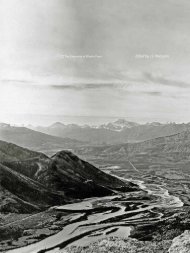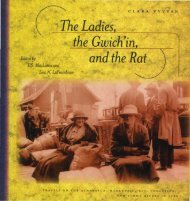Paul Kane's Journal of his Western Travels, 1846-1848 - History and ...
Paul Kane's Journal of his Western Travels, 1846-1848 - History and ...
Paul Kane's Journal of his Western Travels, 1846-1848 - History and ...
You also want an ePaper? Increase the reach of your titles
YUMPU automatically turns print PDFs into web optimized ePapers that Google loves.
forty years developed the strengthened business into a continental<br />
dominion, knowing nearly every post firsth<strong>and</strong> <strong>and</strong> the business<br />
<strong>of</strong> all <strong>of</strong> them intimately. His record-breaking trip in 1824,<br />
which reached Fort George (Astoria) at the mouth <strong>of</strong> the Columbia,<br />
eighty-four days after leaving York Factory on Hudson Bay,<br />
exemplified <strong>his</strong> tenacity, eagerness, <strong>and</strong> sheer devotion to <strong>his</strong><br />
job. (He even had <strong>his</strong> bride. Frances Ramsay Simpson, spend<br />
their honeymoon on a fur trade route [see fourt Franas/Fort<br />
Frames].) Only three <strong>of</strong> <strong>his</strong> forty years' service did not include<br />
an extensive trip. Kane did well, indeed, to keep up to <strong>and</strong> to<br />
impress him, for Simpson's concerns during <strong>1846</strong> were riveted<br />
on the Oregon BoWldary dispute <strong>and</strong> the ramifications <strong>of</strong> its<br />
settlement for the HBC.<br />
Silmon a brother in law <strong>of</strong> the Governur, Mr. Identified as W.<br />
Simpson in WA (67), t<strong>his</strong> is Wemyss M. Simpson (1825-1894),<br />
the youngest brother <strong>of</strong> Frances Ramsay Simpson, Governor<br />
Simpson's cousin <strong>and</strong> wife. Wemyss Simpson joined the HBC<br />
in 1841. When Kane met him in July, <strong>1846</strong>, he was stationed at<br />
York Factory <strong>and</strong> at Oxford House (on the Hayes River, between<br />
NOlway House <strong>and</strong> York Factory).<br />
Simpson had been in charge <strong>of</strong> the post <strong>of</strong> Sault Sainte Marie<br />
for some time when the HBC began to curtail its operations after<br />
1860. Simpson remained, however, serving first as Indian Commissioner<br />
at the Sault, <strong>and</strong> then, in 1867, when Canada came<br />
into being as a dominion, as the Algoma constituency's fust<br />
Member <strong>of</strong> Parliament elected to the House <strong>of</strong> Commons in<br />
Ottawa.<br />
slave ~ See Barriere portage.<br />
Smtheers, the reverant Mr. The Reverend John Smithurst<br />
(1807-1867) went to Gr<strong>and</strong> Rapids (St. Andrew's), on the<br />
lower Red River, in 1840 as a deacon missionary <strong>of</strong> the Church<br />
<strong>of</strong> Engl<strong>and</strong>. He was the first Anglican missionary to attempt to<br />
learn an Indian language. During <strong>1846</strong>, when he hosted Kane,<br />
Smithurst was voluntarily conducting garrison services for the<br />
6th Regiment <strong>of</strong> Foot, detachments <strong>of</strong> which were posted at<br />
Lower Fort Garry (see erNey, Mr. <strong>and</strong> COI&IbIe, Mr.). After<br />
being embroiled in a dispute between the Metis <strong>and</strong> the HBC<br />
regarding secular matters, he resigned, returning to Engl<strong>and</strong> in<br />
1851.<br />
Soto Saulteaux are the westernmost Ojibwa in Canada (Chippewa<br />
in Wisconsin). During the eighteenth <strong>and</strong> nineteenth centuries,<br />
many <strong>of</strong> those Ojibwa <strong>and</strong> Ottawa who hired on as freeman<br />
trappers with the North West Company at Lachine (west <strong>of</strong><br />
Montreal) stayed in the West. Moving beyond the Great Lakes in<br />
the 1780s, the Saulteaux - these Indians were named by the<br />
voyageurs after the "jumping waters" <strong>of</strong> Sault Sainte Marie -<br />
took up territory along the Winnipeg River, on the eastern shore<br />
<strong>of</strong> Lake Winnipeg, <strong>and</strong>, when aligned with the Metis, on the<br />
prairie west <strong>of</strong> Red River. Because the smallpox epidemic <strong>of</strong><br />
1836 diminished their numbers less than it did other tribes', it<br />
appears that the Saulteaux had built an immunity to the disease<br />
from earlier contact with Europeans.<br />
spder Isl<strong>and</strong>s See Lake Winapeg.<br />
the spocan The Spokane River, a tributary <strong>of</strong> the Columbia, flows<br />
out <strong>of</strong> Coeur d' Alene Lake in Idaho, joining the Colwnbia near<br />
its first great bend in American territory, in northeastern Washington<br />
state.<br />
Spokan Fort/spocan Fort Spokane House was not visited by<br />
The American Art <strong>Journal</strong>/Volume XXI • Number 2<br />
Kane. The North West Company established a fort on the<br />
Spokane River in 1810. It was situated on the east bank at<br />
Spokane Falls, ten miles northwest <strong>of</strong> modem Spokane, Washington.<br />
In 1826, the HBC ab<strong>and</strong>oned the post in favor <strong>of</strong> Fort<br />
Colville.<br />
stincun river In 1860, on the map made by the British exploring<br />
expedition, under Captain John Palliser, "Riviere Sale or<br />
Stinking River" is shown flowing from west to east into the<br />
Red River just south <strong>of</strong> the forks <strong>of</strong> the Red <strong>and</strong> the Assiniboine<br />
(at Upper Fort Garry). The river's name today is La Salle, a<br />
euphemistic but confusing homonym that improves sale, the<br />
French for "dirty," into the name <strong>of</strong> the celebrated discoverer<br />
<strong>of</strong> the Mississippi River, who never set foot in the region <strong>of</strong><br />
lower Red River.<br />
Although the low-lying l<strong>and</strong> through which Kane was strug<br />
gling <strong>of</strong>ten flooded for miles around when the Red River<br />
overflowed its banks, Kane seems to have encountered a<br />
notably wet season. Palliser's map describes the area a.\<br />
"Level Plains with long rich grass, being an Ancient Lake<br />
bottom." Not so ancient, Kane was finding.<br />
Stone Fort Red River/Iowr fort Lower Fort Gany (est.<br />
1831) was visited by Kane June 13-14, <strong>and</strong> again on July 5,<br />
<strong>1846</strong>. T<strong>his</strong> fort, at St. Andrews, twenty miles down the Red<br />
River from Upper Fort Garry, was built with a distinctive solid<br />
stone wall around it.<br />
straits/Strates By "straits," Kane seems to mean Juan de Fuca<br />
Strait; by "Strates," the Strait <strong>of</strong> Georgia. The first is the ocean<br />
between Vancouver Isl<strong>and</strong> <strong>and</strong> the northern coast <strong>of</strong> Washington<br />
state. The Reverend Samuel Purchas reported in Hakluytus<br />
Posthumus (1625) that one Michael Lok told him <strong>of</strong> meeting in<br />
Venice in 1596 Apostolos Valerianos (also known as Juan de<br />
Fuca), who claimed that, while serving on Spanish ships, he had<br />
discovered, between 47° <strong>and</strong> 48° latitude, the Strait <strong>of</strong> Artian, the<br />
mythical canal from the Atlantic to the Pacific oceans. However<br />
apocryphal, the story was recalled in the eighteenth century by<br />
the British merchant, John Meares, who named the strait "John<br />
de Fuca" in 1787.<br />
-The Strait <strong>of</strong> Georgia was named for George ill in 17fJ2 by its<br />
discoverer, the British explorer Captain George Vancouver.<br />
sturgun river See Lake Winapeg.<br />
Sursees Sarcee are a fonner Athapaskan, or Dene, tribe who split<br />
from a northern tribe <strong>and</strong> moved south to the Plains, aligning<br />
themselves with such disparate tribes as the Blackfoot, Cree, <strong>and</strong><br />
Stoney. Their retention <strong>of</strong> the Athapaskan language distinguishes<br />
them from other Plains tribes. Their hunting took them<br />
across the northern Plains; their reserve today is on the Elbow<br />
River, contiguous with the southwest limits <strong>of</strong> the city <strong>of</strong> Calgary,<br />
Alberta.<br />
ToImey, Dr. Trained as a surgeon, William Fraser Tolmie (1812-<br />
1886) joined the HBC in 1833, serving at posts on the northern<br />
Pacific coast before starting the Puget Sound Agricultwal<br />
Company's fann at Nisqually in 1843. He was promoted to<br />
Chief Trader the month before Kane met him, <strong>and</strong> to Chief<br />
Factor in 1855. In later decades, Tolmie turned <strong>his</strong> career to<br />
administration, politics, <strong>and</strong> private fanning on Vancouver<br />
Isl<strong>and</strong>.<br />
Tom-a-quin Chief <strong>of</strong> the Cascades (Watlala), a tribe <strong>of</strong> the<br />
Chinook family, Tomaquin returned the Hawaiians who had<br />
85
















